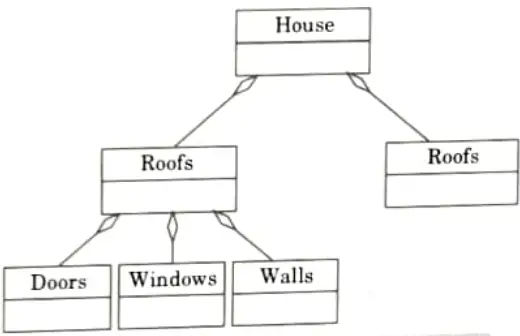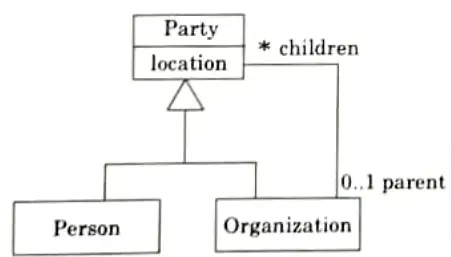Quantum Notes on Object Oriented Programming/System Design can help you succeed in Aktu Btech. Access crucial insights and frequently asked questions for excellent exam success. Improve your academic performance today! Unit-2 Basic Structural Modeling
Dudes 🤔.. You want more useful details regarding this subject. Please keep in mind this as well. Important Questions For Object Oriented Programming/System Design: *Aktu Quantum *B.tech-Syllabus *Circulars *B.tech AKTU RESULT * Btech 3rd Year * Aktu Solved Question Paper
Q1. What is UML ? Mention the different kinds of modeling diagrams used.
Ans. There are three important types of modeling:
- 1. Structural Modeling:
- a. Structural modeling captures the static features of a system.
- b. Structural model represents the framework for the system and this framework is the place where all other components exist.
- c. Hence, the class diagram, component diagram and deployment diagrams are part of structural modeling.
- d. They all represent the elements and the mechanism to assemble them.
- e. The structural model never describes the dynamic behavior of the system.
- 2. Behavioral Modeling:
- a. Behavioral model describes the interaction in the system.
- b. It represents the interaction among the structural diagrams.
- c. Behavioral modeling shows the dynamic nature of the system.
- d. It consists of Activity diagrams, Interaction diagrams, Use case diagrams.
- 3. Architectural Modeling:
- a. Architectural model represents the overall framework of the system.
- b. It contains both structural and behavioral elements of the system.
- c. Architectural model can be defined as the blueprint of the entire system.
- d. Package diagram comes under architectural modeling.
UML:
- 1. UML stands for Unified Modeling Language.
- 2. UML is a pictorial language used to make software blueprints.
- 3. UML can be described as a general purpose visual modeling language to visualize, specify, construct, and document software system.
- 4. lt is also used to model non-software systems as well.
- 5. UML is not a programming language but tools can be used to generate code in various languages using UML diagrams.
- 6. UML has a direct relation with object-oriented analysis and design.
Q2. Define aggregation and generalization. Explain.
Ans. Generalization and specialization: Generalization and specialization represent a hierarchy of relationships between classes, where subclasses inherit from super-classes.
1. Generalization:
- i. In the generalization process, the common characteristics of classes are combined to form a class in a higher level of hierarchy, i.e., subclasses are combined to form a generalized super-class.
- ii. It represents an “is – a- kind-of” relationship. For example, “car is a kind of land vehicle”, or “ship is a kind of water vehicle”.
2. Specialization:
- i. Specialization is the reverse process of generalization. Here, the distinguishing features of groups of objects are used form specialized classes from existing classes.
- ii. It can be said that the subclasses are the specialized versions of the super-class.
The following figure shows an example of generalization and specialization.



Relation to inheritance:
- 1. Developers use the term generalization or inheritance to refer to the same concept of reusing shared attributes and operations that you show. in a superclass and reuse in subclasses.
- 2. Generalization refers to the concept of generalizing from specifics (the subclasses) to the generic (the superclass).
- 3. Inheritance refers to the effect of generalization on the subclasses.
Aggregation :
- 1. Aggregation is a stronger form of association. It represents the has-a or part-of relationship.
- 2. An aggregation association depicts a complex object that is composed of other objects.
- 3. For example, we may characterize a house in terms of its roof, floors, foundation, walls, rooms, windows, and so on. A room may, in turn be, composed of walls, ceiling, floor, windows, and doors, as represented in Fig.



- 4. Hence object aggregation helps us describe models of the real world that are composed of other models, as well as those that are composed of still other models.
Q3. Explain class and object diagrams with examples.
Ans. Class diagram:
- 1. Class diagram is a static diagram.
- 2. t represents the static view of an application.
- 3. Class diagram is used for visualizing, describing, and documenting different aspects of a system and also for constructing executable code of the software application.
- 4. Class diagram describes the attributes and operations of a class and also the constraints imposed on the system.
- 5. The class diagrams are widely used in the modeling of object-oriented systems because they are the only UML diagrams, which can be mapped directly with object-oriented languages.
For example :



Object diagram:
- 1. Object diagrams represent an instance of a class diagram.
- 2. Object diagrams represent the static view of a system but this static view is a snapshot of the system at a particular moment.
- 3. Object diagrams are used to render a set of objects and their relationships as an instance.
For example:



Q4. Prepare a portion of an object diagram for a library book checkout system that shows the date a book is due and the late charges for an overdue book as derived objects.
Ans.



Q5. Explain Polymorphism, Iterated Messages and use of self in message in collaboration diagram.
Ans. Polymorphism:
- 1. Polymorphism means having many forms.
- 2. Polymorphism is the ability of a message to be displayed in more than one form.
- 3. It plays an important role in allowing objects having different internal structure to share the same external interface.
Iterated messages :
- 1. Collaboration diagrams use syntax similar to sequence diagrams to indicate that either a message iterates (is run multiple times) or is run conditionally.
- 2. We can indicate that a particular message iterates by prefixing a message sequence number with an iteration expression.
- 3. We can simply use an asterisk (*) to indicate that a message runs more than once, or we can get more specific and show the number of times a message is repeated.
- 4 To indicate that a message is run conditionally, we can prefix the message sequence number with a conditional clause such as [x = true].
- 5. This indicates that the message is sent only if the condition is met.
- 6. The UML leaves the syntax of conditional clauses wide open, so we can create expressions that make sense in the context of our application.
Use of self in message:
- 1. Self represents the ability of an object to send a message to itself.
- 2. Messages in collaboration diagrams are shown as arrows pointing from the client object to the supplier object.
- 3. Messages represent a client invoking an operation on a supplier object.
- 4. Message icons have one or more messages associated with them.
- 5. Messages are composed of message text prefixed by a sequence number.
- 6. This sequence number indicates the time-ordering of the message.
Q6. What do you understand by basic behavioural modeling ?
Ans.
- i. Behavioral models describe the internal dynamic aspects of an information system that supports the business processes in an organization.
- ii. During analysis, behavioral models describe what the internal logic of the processes is without specifying how the processes are to be implemented.
- iii. In the design and implementation phases, the detailed design of the operations contained in the object is fully specified.
- iv. There are two types of behavioral models. First, there are behavioral models that are used to represent the underlying details of a business process portrayed by a use case model. In UML, interaction diagrams (sequence and communication) are used tor this type of behavioral model
- v. Second, there is a behavioral model that is used to represent the changes that occur in the underlying data. UML uses behavioral state machines for this.
- vi. During the analysis phase, analysts use behavioral model to capture a basic understanding of the dynamic as pects ot the underlying business process.
- vii. Traditionally, behavioral models have been used primarily during the design phase where analysts refine the behavioral models to include implementation details.



Important Question with solutions | AKTU Quantums | Syllabus | Short Questions
Object Oriented Programming/System Design Btech Quantum PDF, Syllabus, Important Questions
| Label | Link |
|---|---|
| Subject Syllabus | Syllabus |
| Short Questions | Short-question |
| Question paper – 2021-22 | 2021-22 |
Object Oriented Programming/System Design Quantum PDF | AKTU Quantum PDF:
| Quantum Series | Links |
| Quantum -2022-23 | 2022-23 |
AKTU Important Links | Btech Syllabus
| Link Name | Links |
|---|---|
| Btech AKTU Circulars | Links |
| Btech AKTU Syllabus | Links |
| Btech AKTU Student Dashboard | Student Dashboard |
| AKTU RESULT (One VIew) | Student Result |
